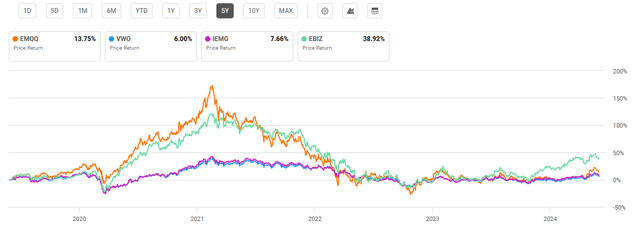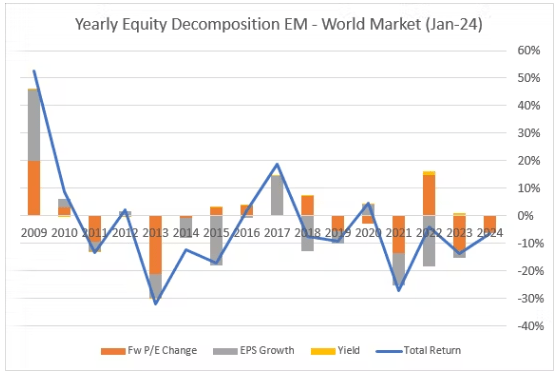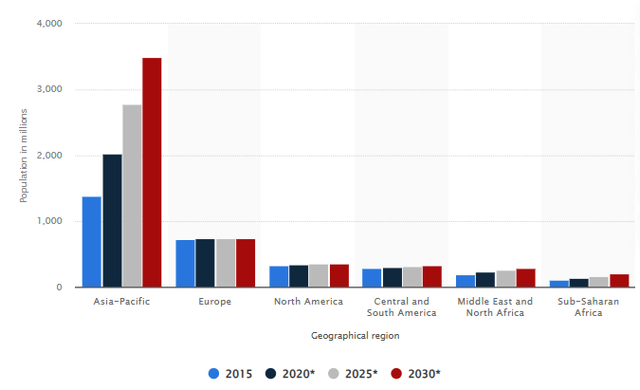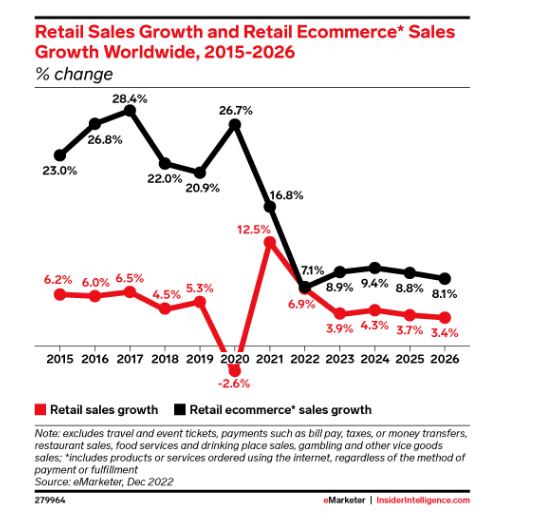Investment Thesis
The Emerging Markets Internet & Ecommerce ETF (NYSEARCA:NYSEARCA:EMQQ) is a hold due to its risk and high expense ratio compared to its return potential. While the fund aptly focuses on the growing consumption of internet and ecommerce for the middle class of emerging markets, its trend of underperformance will likely continue. Additionally, there are alternative global internet and ecommerce funds that are better capable of capturing this emerging market demand, with lower expense ratios, and potentially lower risk.
Fund Overview and Compared ETFs
EMQQ is an actively-managed ETF that seeks to capture emerging market companies in internet and ecommerce industries. Launched in 2018, the fund is rebalanced semiannually and has 112 holdings along with $377.25M in AUM. By sector, the fund is heaviest on communications (41.74%), followed by consumer discretionary (34.74%) and financials (9.33%). By nation, EMQQ has the greatest weight in China (53.37%), followed by India (16.22%) and Argentina (7.73%). A primary objective behind the ETF, discussed in further detail later, is to capture the growth of middle classes in emerging markets as they pursue products like smartphones and utilize online commerce.
For comparison purposes, other funds examined are Vanguard FTSE Emerging Markets ETF (VWO), iShares Core MSCI Emerging Markets ETF (IEMG), and Global X E-Commerce ETF (EBIZ). For investors seeking a well-diversified emerging markets fund, VWO is comparable to Schwab’s equivalent emerging markets fund (SCHE). VWO is the largest fund by AUM and the most diversified of ETFs examined. IEMG includes 22.54% weight on information technology and 20.17% on financials. It is still highly diversified with almost 3,000 holdings but is more focused on technology holdings than VWO. Unlike all other funds, EBIZ is technically a global fund versus emerging markets and its weight by country is 51.0% in U.S., 23.10% in China, and 7.3% in Canada. EBIZ is also the least diversified with only 40 holdings.
Fund Comparison: Performance, Expense Ratio, and Dividend Yield
Emerging market funds saw a strong rise in value in 2020 which peaked in 2021 predominantly driven by Chinese tech companies. Taiwan Semiconductor Manufacturing (XTAI:2330) and Tencent Holdings (XHKG:700), for example, saw their share prices roughly double in 2020 alone. Subsequently, nearly all the strong returns for EMQQ in 2020 were lost by the end of 2023. EMQQ has seen a 5-year average annual return of -0.29% with a total return of 13.75%. By comparison, peer funds have seen similar or better returns with less volatility. VWO has a 5-year average annual return of 2.69%, compared to IEMG’s 5-year average return of 2.80% and EBIZ’s 5-year average return of 6.70%.
5-Year Total Price Return: EMQQ and Compared EM Funds (Seeking Alpha)
A major downside for me is EMQQ’s high expense ratio at 0.86%. This is higher than all other compared funds and also higher than the average ETF expense ratio of 0.57%. This would be palatable if EMQQ saw consistent stellar performance. However, as we covered earlier, this has not necessarily been the case. Broadly diversified VWO and IEMG have a substantial dividend yield. Due to EMQQ’s focus on internet and e-commerce holdings, its dividend yield is significantly lower at 0.72%. However, EMQQ’s dividend has been growing with a 29.23% 3-year CAGR.
Expense Ratio, AUM, and Dividend Yield Comparison
|
EMQQ |
VWO |
IEMG |
EBIZ |
|
|
Expense Ratio |
0.86% |
0.08% |
0.09% |
0.50% |
|
AUM |
$377.25M |
$103.81B |
$77.67B |
$67.51M |
|
Dividend Yield TTM |
0.72% |
3.38% |
2.78% |
N/A |
|
Dividend Growth 3 YR CAGR |
29.23% |
14.74% |
7.98% |
N/A |
Source: Seeking Alpha, 1 Jun 24
EMQQ Holdings and Emerging Market Outlook Factors
With 112 holdings, EMQQ is much less diversified than broadly-based VWO and IEMG. However, it still has similar holdings such as Reliance (XNSE:RELIANCE) and Tencent Holdings. Because EBIZ is a global fund, EMQQ has few similarities also such as Sea Ltd (SE).
Top 10 Holdings for EMQQ and Compared Emerging Markets ETFs
|
EMQQ – 112 holdings |
VWO – 5,846 holdings |
IEMG – 2,941 holdings |
EBIZ – 40 holdings |
|
RELIANCE – 8.80% |
2330 – 7.02% |
2330 – 7.40% |
CVNA – 8.11% |
|
700 – 8.32% |
700 – 3.40% |
700 – 3.62% |
SE – 6.53% |
|
9988 – 7.73% |
9988 – 2.00% |
005930 – 2.96% |
WSM – 4.99% |
|
MELI – 7.65% |
RELIANCE – 1.49% |
9988 – 1.85% |
TCOM – 4.80% |
|
PDD – 7.56% |
HDFCBANK – 1.28% |
RELIANCE – 1.21% |
GDDY – 4.63% |
|
3690 – 7.32% |
PDD – 0.95% |
PDD – 1.06% |
EBAY – 4.56% |
|
NPN – 3.69% |
3690 – 0.92% |
000660 – 0.90% |
JD – 4.16% |
|
9618 – 3.45% |
939 – 0.76% |
3690 – 0.82% |
W – 4.05% |
|
SE – 3.45% |
INFY – 0.75% |
ICICIBC – 0.81% |
4755 – 3.98% |
|
NETTF – 3.19% |
2317 – 0.72% |
939 – 0.80% |
RBA – 73.49% |
Source: Multiple, compiled by author on 1 Jun 24
Looking forward, there are multiple reasons to be both cautious and optimistic for emerging market funds and EMQQ. While emerging markets have seen significant underperformance, there are multiple growth factors that may reverse this trend. However, EMQQ’s holdings are based in emerging market locations that present significant risk. In contrast, EBIZ is more strongly postured as its top holdings can take advantage of emerging market growth while being physically located in developed countries. These outlook factors are covered in further detail below.
Why Traditional EM Funds Have Underperformed
Emerging markets have significantly underperformed U.S. domestic equities over the past 25 years. While the S&P 500’s total 10-year return has been over 170%, emerging markets have been virtually flat. Home bias, outflows in emerging market investment over the past 10 years, and geopolitics all play factors into underperformance over the past two decades. However, a more direct factor is that emerging market equities have simply seen sub-par earnings. Price-to-earnings and earnings per share growth has been low and, in many years, even negative.
Emerging Market Equity Performance (Macrobond)
Another risk factor is that emerging markets tend to be largely weighted on specific sectors and companies. We see this today with Taiwan Semiconductor Manufacturing and Tencent Holdings. Because only about 27% of the total global market cap is from emerging markets, ETFs are particularly sensitive to a handful of top holdings.
EMQQ’s Greater Potential Than Larger, More Diversified EM Funds
Although emerging markets have underperformed this past decade, there are reasons to be optimistic. While emerging markets only made up about 27% of global market cap recently, this is up substantially from 19% in 2009. Goldman Sachs even predicts that emerging markets will reach 47% in 2050 along with 60% of global GDP. Most of this astounding increase is due to the growth of emerging markets’ middle class. The projected global middle-class population growth by region is explosive in Asia-Pacific while Europe and North American middle class population growth is stagnant.
Forecast Growth of Middle-Class Populations by Region (Statista, 1 Jun 24)
According to Global X, e-commerce is expected to increase from less than 20% to 23% of global retail sales through 2027. Emerging market middle classes will be consuming new goods and services such as cell phones and the internet. Therefore, while broad-based VWO and IEMG capture a more diversified sectors of the emerging market, I believe EMQQ is well postured to best capture consumer demand for this growing middle class.
Why EBIZ Will Likely Outperform EMQQ
Despite the competitive advantages of EMQQ over broadly diversified VWO and IEMG, a key drawback is that the companies captured within its holdings are also within emerging market nations. While global retail ecommerce is expecting to increase upwards of 8% year-over-year, this growth does not necessarily need to be captured by companies physically located within emerging nations.
Global Ecommerce Sales Growth Through 2026 (eMarketer, 2022)
Importantly, EBIZ is an ETF that captures holdings that benefit from both emerging market middle class and ecommerce growth while also reducing risk by the physical locations of its companies. GoDaddy (GDDY), EBIZ’s #5 holding, is an example of a U.S.-based company that is benefiting from emerging markets growth by selling its services to 200 markets worldwide. According to its last annual report, GoDaddy states that 48% of its customer base and approximately one third of its revenue was from international sources. eBay (EBAY) is another company that provides ecommerce across 190 counties. While eBay has only about 9% of its tangible assets located outside the United States, the company saw 50% of net revenues from international sources, according to its last annual report. Both companies therefore see reduced geopolitical risk while capturing EM consumer demand.
Current Valuation
Emerging markets have seen relative success compared to developed markets in keeping inflation under control. Additionally, strong global demand has meant that emerging markets have done well over the past year. As a result, all EM funds examined have seen returns over 10% since summer 2023. EMQQ specifically has seen a one-year return of over 20%, nearly as strong as the S&P 500 Index. However, it underperformed EBIZ which globally includes internet and ecommerce holdings within the United States.
One-Year Performance: EMQQ and Compared ETFs (Seeking Alpha)
As a result of strong performance for EMQQ and EBIZ, both funds have higher valuations compared to broadly diversified VWO and IEMG. Looking at price-to-earnings and price-to-book ratios, EMQQ is more attractively valued than EBIZ but significantly more expensive than VWO and IEMG. However, given the unique strengths of EMQQ and EBIZ, I do not see VWO and IEMG as a buy for reasons already discussed. In contrast, while EBIZ has the highest P/E and P/B ratios, I believe it has the strongest potential to capture emerging market revenue growth.
Valuation Metrics for EMQQ and Peer Competitors
|
EMQQ |
VWO |
IEMG |
EBIZ |
|
|
P/E ratio |
24.85 |
14.50 |
15.22 |
27.96 |
|
P/B ratio |
2.60 |
2.10 |
1.78 |
3.97 |
Source: Compiled by Author from Multiple Sources, 1 Jun 24
Risks to Investors
As discussed, all emerging market funds have a significant level of risk due to their concentration on certain sectors and companies as well as for their geopolitical exposure. Overall volatility can be measured by each fund’s standard deviation. EMQQ and EBIZ both have a standard deviation of roughly 30 over the past five years, with a beta compared to the MSCI emerging markets of 1.52. While this represents a relatively high amount of volatility, I believe EBIZ holds less geopolitical risk due to its global diversification. Numerous other factors, including the tensions between China and Taiwan and Chinese internet restrictions, all represent unknown variables and additional risks to investors.
Concluding Summary
The decade between 2010 and 2020 was the worst 10-year period for emerging market returns since the 1930s. However, there are multiple reasons to believe that emerging markets are primed for a comeback, including massive growth in its middle-class populations that will increase consumer demand for goods and services such as cell phones and internet access. Therefore, while broadly-based VWO and IEMG may have greater diversification, EMQQ is better positioned to capture this demand. However, top holdings for EMQQ still face a significant level of risk. For this reason, I believe EBIZ, which includes both emerging market and U.S. based companies, is best poised to capture this emerging market growth. Finally, EMQQ has the highest expense ratio of compared funds which is a major negative factor in my opinion.
Read the full article here



